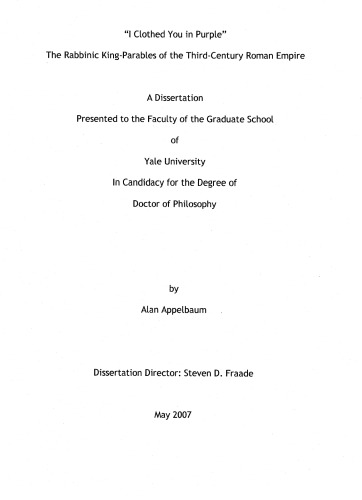موضوعات
آموزش و پرورش
ادبیات و زبان
پزشکی، دندانپزشکی و داروسازی
تاریخ و جغرافیا
داستان و رمان
دیگر
دین و فلسفه
روانشناسی
ریاضیات و آمار
سلامتی، تناسب اندام و رژیم غذایی
شیمی و پلیمر
علوم اجتماعی و حقوق
علوم زیستی و بیوتکنولوژی
فیزیک و نجوم
کامپیوتر و اینترنت
کتابهای کودکان و داستان
کسب و کار و اقتصاد
کشاورزی و دامپزشکی و غذا
معماری
مهندسی و فناوری
هنر و تئاتر
محصولات
“I clothed you in purple”: The Rabbinic king-parables of the third-century Roman Empire - Original PDF
نویسندگان: خلاصه: Abstract"I Clothed You in Purple"The Rabbinic King-Parables of the Third-Century Roman EmpireAlan AppelbaumMay 2007This is an analysis of comparisons the Rabbis made with kings, limited toRoman Palestine and to the ninety-year period beginning with the accession ofthe Emperor Septimius Severus in 193 C.E. and ending with the accession ofDiocletian. Based primarily on the original rabbinic texts, it also draws ontraditional Greek and Latin sources of imperial history and brings contemporarytheory to bear.A major part of the study re-examines current scholarly views aboutking-parables and finds them wanting - including the still prevalentpresupposition that "the king" is usually modeled on the emperor; the idea,recently renewed by Daniel Boyarin, that the Rabbis told the parables to makeTorah accessible to non-Rabbis; and, most important, the idea, championed byDavid Stern, that "the king," no matter what earthly ruler he is modeled on, isa stand-in for God. The study also supplements the ongoing work on king-parables being done by Clemens Thoma and his colleagues in Switzerland.As the study attends to the king-parables' form, structure, functions,settings and characters, it emphasizes the Rabbis' distinctive ideas about therelationship of humanity to God.Since the parables were produced by an intellectual elite in a countryoccupied by a world-empire, the study considers them as resistance literatureand explores what contemporary post-colonial theory and James C. Scott'swork concerning "hidden transcripts" may have to say about them.And since scholars of Roman history traditionally bemoan the paucity ofsources for the period, it poses the hypothesis that making comparisons to"kings" modeled on emperors or their representatives involves at least thinkingone knows something about them. The Rabbis' accounts of such "kings" notonly shed light on the attitudes of a group of literate citizens in a particulareastern province toward living, breathing emperors but also provideinformation about third-century imperial history, sometimes confirminggenerally accepted readings of traditional sources, sometimes supportingsources that have been regarded as questionable, and sometimes helping toresolve open issueOn the Ball: What You Can Learn About Business From America's Sports Leaders - PDF
نویسندگان: خلاصه: Sports, like business, is a nonstop, flat-out competition where winners prosper and losers are sent packing. Think the multi-billion-dollar sports industry might have something to teach your business? You better believe it. With On the Ball, you will learn those lessons before your competitors do. Get in the sports business game and learn about breakthrough techniques for building a business. Reaching customers. Delivering customer service. Branding yourself and your business. Handling employee relations. Alliance building. Crisis management. Entering new markets. Turning around a business. Leadership. All that, plus your own personal behind-the-scenes tour of the sports industry-courtesy of top sports business consultant David M. Carter and ESPN.com’s Darren Rovell. Hop on. It'll be a fun ride. A very profitable fun ride. * Branding, NBA style Powerful branding lessons from David Stern, Michael Jordan & Co. * Strategic alliances with the New York Yankees Win-win partnerships with George Steinbrenner * Building your business the way NASCAR did it Fast lane from the backwoods to NBC Sports * Terrorism to bribery: practical lessons in crisis management Straight from sports, 10 steps for handling any business crisis * Penetrate and dominate: Nike in new markets How Tiger Woods helped Nike go global * Know your fan, know your customer Take a tour of the baseball minor leagues and see how to really please your customers Today's most powerful business lessons... ...you could learn them from some boring business school text. But, hey, life's too short. With On the Ball, you can learn the same lessons from sports! Top sports business consultant David M. Carter and ESPN.com sports business journalist Darren Rovell serve up winning techniques straight out of the big leagues. Business is a sport, and sport's a business, right? So why not learn... * Entrepreneurship from NASCAR's Bill France Sr. * Target marketing the MasterCard way * Customer service from the late great Bill Veeck * Personal branding from cyclist Lance Armstrong and women's tennis player Anna Kournikova * Employee relations from Major League Baseball * Strategic alliances from New York Yankees owner George Steinbrenner * Crisis Management from NFL Commissioner Paul Tagliabue * Penetrating new markets using Tiger Woods * Brand building from NBA Commissioner David Stern * Turnarounds from Dallas Cowboys owner Jerry Jones * Leadership from Notre Dame head football coach Tyrone Willingham Fast, furious, outrageous, and unforgettable, On the Ball is everything you expect from sports, and don't expect from a business book!آیا کتاب مورد نظر هنوز بر روی سایت قرار نگرفته است؟ جای نگرانی نیست! کافی است بر روی گزینه سفارش کتاب کلیک کرده و درخواست خود را ثبت کنید. در کمتر از چند ساعت کتاب شما را آماده خواهیم کرد.


